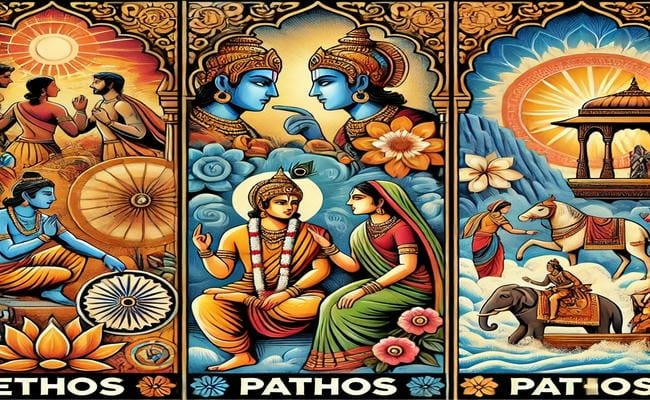
How Do You Use Seedminer To Get Movable.sed
January 17, 2025
How Has Simone Biles Responded To Racially-motivated Insults
January 17, 2025Hindu mythology is rich in stories and teachings that align with Aristotle’s rhetorical appeals of ethos, pathos, and logos. These elements are used to convey moral lessons, inspire devotion, and provide logical frameworks for understanding life and the universe.
Why Connect Hindu Mythology to Ethos, Pathos, and Logos?
- Cultural Insight: Explore how ancient wisdom employs rhetoric for teaching and persuasion.
- Universal Themes: Discover parallels between mythology and modern communication strategies.
- Enriched Understanding: Appreciate the depth of Hindu narratives and their rhetorical sophistication.
How Hindu Mythology Reflects Ethos, Pathos, and Logos
- Ethos (Credibility and Ethics):
- Divine Authority: Characters like Lord Rama and Lord Krishna embody moral integrity and ethical leadership.
- Scriptural Foundations: Texts like the Bhagavad Gita establish credibility through their divine origins and timeless teachings.
- Role Models: Heroes and sages in mythology serve as ethical exemplars, reinforcing virtuous behavior.
- Pathos (Emotional Appeal):
- Emotional Narratives: Stories like the exile of Sita evoke empathy and compassion, connecting audiences emotionally.
- Devotional Practices: Myths inspire feelings of reverence and devotion through vivid depictions of gods and their deeds.
- Human Struggles: Relatable characters and conflicts create emotional resonance, making lessons impactful.
- Logos (Logical Appeal):
- Philosophical Dialogues: The Bhagavad Gita’s discourse between Krishna and Arjuna uses logic to resolve moral dilemmas.
- Cosmic Order: Concepts like dharma (duty) and karma (cause and effect) provide a rational structure for life.
- Symbolic Stories: Mythological events are often allegorical, offering logical explanations for natural phenomena and human behavior.
Examples of Rhetorical Appeals in Hindu Mythology
- Ethos: Rama’s unwavering adherence to dharma in the Ramayana establishes his credibility as an ethical leader.
- Pathos: Draupadi’s humiliation in the Mahabharata elicits strong emotional reactions, driving home the need for justice.
- Logos: The cyclical nature of creation and destruction in Hindu cosmology appeals to logical understanding.
Lessons from Mythology for Modern Communication
- Build Credibility: Like mythological figures, establish trust through consistent and ethical behavior.
- Engage Emotions: Use storytelling to connect with audiences on a personal level.
- Present Rational Arguments: Balance emotional appeals with logical reasoning to persuade effectively.
Also Read: How Do You Use Seedminer To Get Movable.sed
Conclusion
Hindu mythology beautifully integrates ethos, pathos, and logos to convey profound lessons and inspire audiences. By understanding these connections, we can appreciate the enduring relevance of these ancient narratives in shaping ethical, emotional, and logical perspectives.




